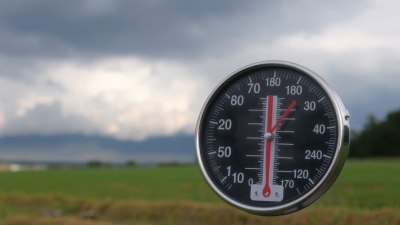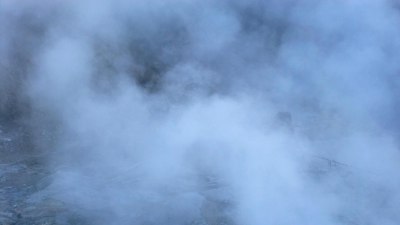How Air Pressure Drops Signal Developing Weather Systems
Explore how falling air pressure indicates approaching weather changes and developing weather systems.

Air pressure, also known as atmospheric pressure, is the force exerted by the weight of the atmosphere above a particular point on Earth's surface. It is a fundamental factor in meteorology and plays a critical role in predicting weather patterns. A drop in air pressure often signals the development or approach of a weather system, such as a storm or a frontal boundary, making it crucial for understanding upcoming weather changes.
Atmospheric pressure is measured using barometers and is typically expressed in units such as millibars (mb) or inches of mercury (inHg). At sea level, the average air pressure is approximately 1013.25 mb or 29.92 inHg. Variations in air pressure, whether increasing or decreasing, can reveal much about the state of the atmosphere and impending weather.
What Causes Air Pressure to Drop?
The primary cause of a drop in air pressure is the rising of warm air in the atmosphere. Warm air is less dense and lighter than cold air, so when a region of air heats up, it expands and begins to rise. As the warm air rises, it reduces the weight of the air pressing down on the surface, resulting in lower pressure readings.
This upward motion is a key driver behind many weather systems. For example, low-pressure systems often feature rising warm moist air, which can condense to form clouds and precipitation. This process is why drops in air pressure frequently precede rain, storms, or even more severe weather conditions like hurricanes.
Other factors that can influence air pressure drops include the movement of air masses and the presence of fronts. When a cold front advances, it pushes warmer air upwards, initiating a pressure drop and often triggering precipitation. Conversely, a warm front slides over cooler air, also causing gradual pressure changes and cloud development.
Low-Pressure Systems and Weather Development
Low-pressure systems, sometimes called cyclones or depressions, are areas where the atmospheric pressure is lower than the surrounding environment. These systems are associated with cloudy, wet, and often unsettled weather. The key characteristics of low-pressure systems include converging air near the surface that rises and cools, which leads to condensation of water vapor.
The dynamics of a low-pressure system can vary widely based on geographic location, season, and other atmospheric conditions. Generally, the formation of low-pressure centers often heralds changeable weather. For instance, mid-latitude cyclones, which commonly occur between 30 and 60 degrees latitude, develop from the interaction of cold and warm air masses and are major drivers behind much of the temperate weather experienced across many regions.
In the tropics, low-pressure systems can develop into tropical storms or hurricanes when the conditions include warm ocean waters, ample humidity, and low vertical wind shear. The intense drop in pressure at the center of such storms results in high winds and heavy rainfall.
The Relationship Between Air Pressure Drops and Fronts
Fronts represent the leading edges of air masses with different temperatures and humidity levels. The arrival of a front usually causes discernible changes in weather, and these are often accompanied by a drop in air pressure.
Cold fronts tend to cause a rapid drop in pressure followed by a quick change in weather, such as thunderstorms or a sudden drop in temperature. Warm fronts generally cause a more gradual pressure decrease with stratiform clouds and steady precipitation preceding the front’s passage.
Monitoring air pressure variations near frontal zones is essential for forecasting purposes. These pressure trends, combined with temperature and wind observations, allow meteorologists to predict when and where precipitation or storms will occur.
Tools and Methods for Detecting Pressure Changes
Barometers remain the primary instruments for measuring atmospheric pressure. Modern weather stations typically use electronic sensors capable of detecting minute changes in pressure. These data are collected continuously and analyzed to observe trends such as falling pressure that might signal a developing weather system.
Advances in technology have also integrated air pressure data from weather satellites, which can estimate pressure patterns over large regions. Numerical weather models utilize these observations to simulate atmospheric conditions and predict the movement and intensification of weather systems.
In addition to fixed weather stations, mobile platforms like aircraft and weather balloons play critical roles in capturing vertical profiles of pressure and other meteorological parameters. Together, these data sources offer a comprehensive picture of how pressure changes relate to weather development.
Interpreting Pressure Drops in Forecasting
When observing a falling pressure trend, meteorologists consider the rate and magnitude of the drop. A rapid decrease, for instance several millibars per hour, often implies a strengthening weather system and the potential for more severe weather.
Gradual pressure declines might indicate slower moving systems that can bring extended periods of precipitation. In contrast, steady or rising pressure typically suggests stable, clear weather.
It is important to recognize that pressure alone does not paint the entire picture but must be interpreted in conjunction with temperature, humidity, wind patterns, and satellite imagery for accurate forecasting.
Case Studies in Air Pressure Drops and Weather Events
Notable weather events demonstrate the impact of air pressure drops. For example, the rapid pressure decline observed as a hurricane approaches coastal areas serves as an alarm for intensifying winds and impending storm surge. During the landfall of Hurricane Katrina in 2005, barometers showed a sharp pressure drop as the storm neared New Orleans, which correlated with escalating wind speeds and catastrophic flooding.
Another example is the frequent mid-latitude cyclones affecting the United Kingdom. Their approach is often marked by falling pressure, signaling rain and winds that can disrupt daily life across the region. Local meteorologists closely track these pressure changes to deliver timely warnings.
Global Patterns and Air Pressure
On a global scale, large-scale pressure systems such as the Azores High or the Siberian High influence regional climates by controlling prevailing wind patterns and precipitation. Shifts in these systems can cause noticeable pressure drops or rises, affecting weather conditions over vast areas.
Seasonal variations also impact air pressure. For instance, during winter, stronger high-pressure systems tend to form over continents due to lower temperatures and denser air, while summer months often feature lower pressure because of increased surface heating.
Understanding these large-scale pressure patterns aids in long-range weather forecasting and climate studies, helping to anticipate trends like monsoons, droughts, or prolonged rainy seasons.
Practical Applications for Knowing About Air Pressure Drops
For many people, especially those involved in outdoor activities such as sailing, hiking, or farming, recognizing a falling air pressure trend can be valuable. It serves as a natural indicator that rain or storms may be approaching, allowing individuals to prepare accordingly.
In aviation, sudden drops in pressure can be critical. Pilots rely on pressure measurements for altitude readings and for anticipating turbulence or weather changes. Air traffic controllers also monitor pressure patterns to ensure flight safety and efficiency.
Emergency services use pressure data to predict severe weather events, allowing for better resource allocation during storms or floods. This information is vital for community preparedness and disaster mitigation.
Limitations and Exceptions
While drops in air pressure commonly signal deteriorating weather, exceptions exist. For example, localized pressure drops might occur due to terrain effects or temporary atmospheric phenomena that don’t necessarily translate into significant weather changes.
Additionally, some weather systems may develop without dramatic pressure shifts, such as certain types of convection or turbulence in stable regions. Hence, pressure trends are best used as part of a broader suite of meteorological data rather than in isolation.
Moreover, extremely calm conditions can produce nearly stable pressure readings, complicating short-term predictions. Meteorologists continuously refine their understanding of these nuances through research and advanced modeling.
In summary, monitoring drops in air pressure offers significant insight into developing weather systems. Falling pressure suggests rising warm air, cloud formation, and possible precipitation or storms. Low-pressure systems, fronts, and other atmospheric dynamics all contribute to observable pressure changes crucial for weather forecasting.
By combining pressure readings with other meteorological observations, scientists can anticipate delays or intensifications in weather patterns, improving safety and planning for individuals and communities. Understanding air pressure drops thus remains a fundamental pillar of meteorological science and practical weather prediction.











